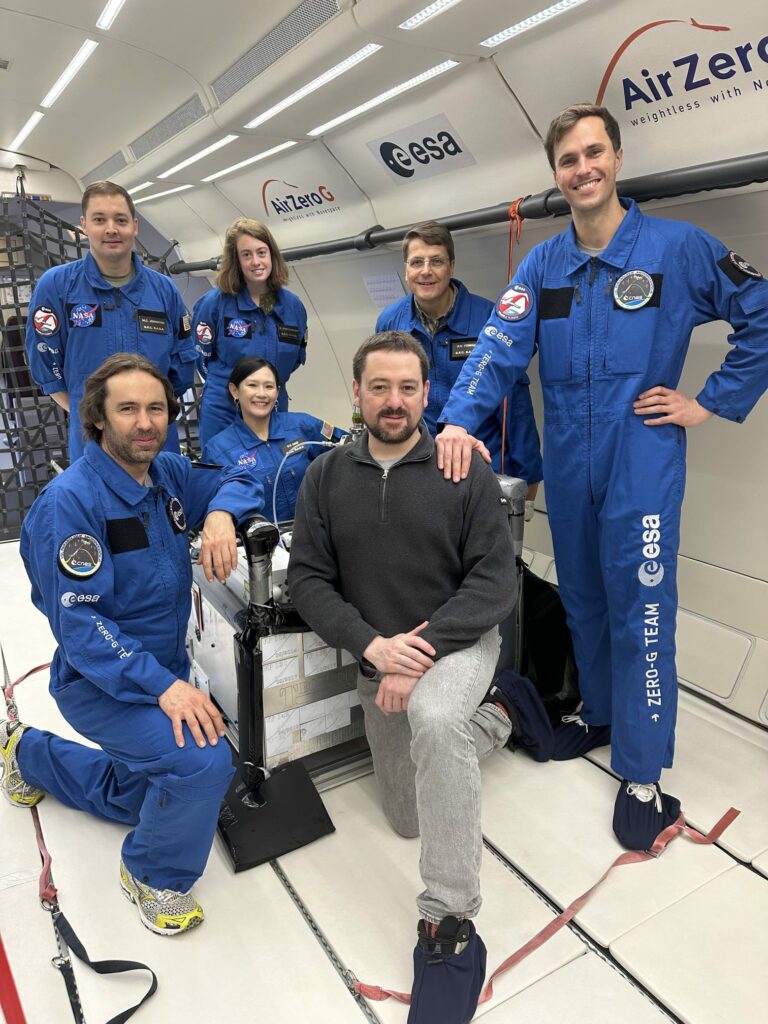DIAMONDS (Detection of Ignition And Mitigation Onboard for Non-Damaged Spacecraft)
Laboratories : ICARE and Inst. D’Alembert

Within the context of spacecraft fire safety, DIAMONDS is an experimental setup allowing the study of flame spread over solid fuel in microgravity. Since 2014, DIAMONDS has been flying the French airplane that operates parabolic flight campaigns. The configuration that has been extensively documentd is a flame spreading over the polymer coating of an electrical wire. Especially in collaboration with japanese colleagues,1 the domain of ambient flow that prohibits/enables the spread has been identified. Numerical simulations developed by J.-L. Consalvi’s group (Aix-Marseille U.) are crucial diagnostics2 to understand the underlying processes that shape this domain.
For a matter of space exploration, the main space agencies are now questioning the findings at intermediate gravity levels. Within the ESA parabolic flight campaign VP172 (April 2023), we investigated flame spread over flat samples at partial gravity levels. The group lead by P. Ferkül (NASA GRC) who has been investigated this configuration for a while3 worked with J.-M. Citerne and DIAMONDS is now equipped to embed the configuration. The euro-american team thus gathered flew for the first time together (see picture) and conducted the associated investigations that are now under analysis.
Fire safety in general is also a matter of mitigation. Starting with a flame ignited over the polymer coating of an electrical wire, the ambient conditions of the flow that enables the spread in microgravity at a steady rate are known from DIAMONDS results. With the support of CNES, the experimental setup UNBURNIT (UNconventional BUrning Response to Non-Invasive Techniques) has been imagined by J.-M. Citerne and A. Guibaud to address the strategies of mitigation by external perturbations. UNBURNIT flew for the 1st time on CNES parabolic flight campaign VP171 (March 2023). While the data are still processed, the movie below shows how resilient a flame can be after a quite shaky acoustic perturbation, further highlighting the need for thorough investigations on mitigation strategies.
Acoustic perturbation of the flame spread with UNBURNIT. The laminar air stream flows from the left parallel to the wire. The flame is ignited over the coating of the wire in microgravity. After the flame spread is well established, a 4s long acoustic perturbation is set ON. The end of the microgravity period can be detected as the flame tip is deflected from the wire’s axis.
Related references :
2 P. Ferkül et al, Comb. Flame 2021
3 J.-L. Consalvi, A. Guibaud, A. Coimbra, J.-M. Citerne, G. Legros. Effects of oxygen depletion on soot production, emission and radiative heat transfer in opposed-flow flame spreading over insulated wire in microgravity. Comb. Flame 230 (2021) 111447
